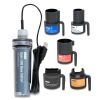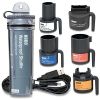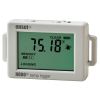HOBOware Pro Software
Features
- Powerful software for logger management, data graphing, data analysis, and data export
- Data Assistants and Real-Time Alarm Plug-ins provide advance data analysis, monitoring and notifications
- Software is licensed per computer and non-refundable upon receipt of license key
- Expedited repair and warranty service
- Lifetime technical support
- More
Overview
HOBOware Pro Software facilitates easy launch and readout of HOBO USB data loggers as well as flexible plotting of data. Data can be exported for more in-depth analysis using other programs including spreadsheets. The software allows users to set launch parameters. These settings include:
- Toggling channels to record
- Setting sample intervals and start type (immediate, delayed, interval, or triggered)
- Monitoring battery level
- Synchronizing logger clocks to the computer clock
Graphing Potential
With the graphing capability, users can view multiple parameters from a single logger on one graph, zoom in on data of interest, set axes ranges, display data in different formats, and display recorded events in graphs or file exports. Users can also verify logger operation before launch or during logging, as well as display real-time sensor readings, memory used, and battery voltage.
Data Conversion
One-click conversion allows for easy data upload into Microsoft Excel software or other programs. Windows and Mac versions are included. The Windows version offers enhanced features that allow for the combination of data from multiple loggers or deployments, saving of current data for future use, linear scaling for external inputs, listing of recently accessed files, and automatic internet updates.
In The News
Monitoring Mariculture in the Gulf of Alaska
The mariculture industry in the Gulf of Alaska has been steadily growing in recent years, guided by ongoing research to help refine farm location and cultivation practices. A subset of aquaculture, mariculture focuses on rearing organisms in the open ocean. In Alaska, finfish farming is illegal, so most farms cultivate kelp, oysters, or a combination of the two. These small, locally operated farms started popping up in the Gulf of Alaska in the early 1990s, when shellfish farming first became legal. Kelp farming did not begin to catch on in the state until 2016. Many of the coastal areas that have grown interested in mariculture are historically commercial fishing communities.
Read MoreSupplying Seattle’s Drinking Water: Using Data Buoys to Monitor the Cedar River Municipal Watershed
Providing clean, safe, and reliable drinking water for the 1.6 million people in the greater Seattle area is a top priority for Seattle Public Utilities (SPU). With limited water supplies, SPU dedicates considerable resources to maintain its watersheds and mountain reservoirs. About 70 percent of Seattle Water comes from the Cedar River Municipal Watershed , and the other 30 percent comes from the South Fork Tolt River Watershed . [caption id="attachment_39574" align="alignnone" width="940"] Data buoy in Chester Morse Lake . (Credit: Kevin Johnson / Seattle Public Utilities) [/caption] Jamie Thompson, a fisheries biologist at SPU, monitors aquatic ecosystems centered on fish listed under the U.S. Endangered Species Act (ESA).
Read MoreData-Driven Advocacy on the Lower Deschutes River
Like many freshwater environments, the Deschutes River in Oregon is under pressure from development, pollution, and climate change. Many rivers, streams and lakes in the Deschutes Basin do not meet Oregon water quality standards –where state water quality monitoring assesses levels of bacteria, pH, dissolved oxygen, temperature, and fine sediment. Hannah Camel is the Water Quality Coordinator for the Deschutes River Alliance (DRA), a non-profit organization that focuses on the health of the lower 100 miles of the Deschutes River–the area most affected by human intervention. As a data-driven organization, the DRA has benefited from the installation of two NexSens X2 data loggers.
Read More












